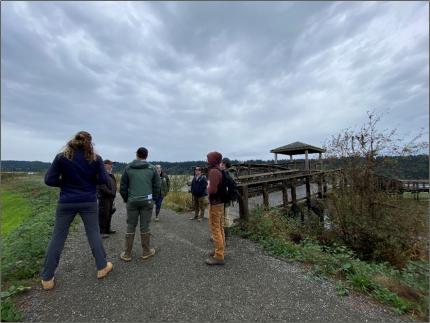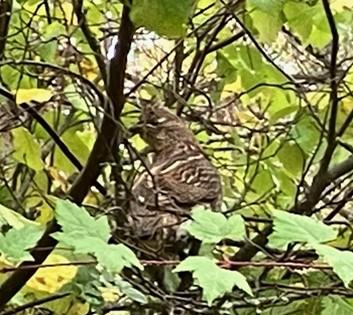
Wildlife Program report: Sept. 16-30, 2023
Managing Wildlife Populations
State-Tribes Recreation Impact Management: Washington Department of Fish and Wildlife (WDFW) is working with federally recognized tribes and other state agencies to develop a framework for managing recreation impacts on state lands. Lands Division Manager Wilkerson and Lands Recreation and Planning Manager Sisolak staff this work on behalf of Washington State Department of Fish and Wildlife. The Steering Committee met on Sep. 21. Bob Whitener from the Whitener Group has been contracted to facilitate this work and was introduced at the Sep. 21 meeting.
Providing Recreation Opportunities
Trail Inventory Projects: Partnership Coordinator Browning and Recreation Planner Andersen continue to meet with land managers to discuss trail inventory projects in the coming year. Trail inventory projects will likely be taking place in Scatter Creek, Cowlitz, Wooten, Columbia Basin, and Wenas wildlife areas. Additionally, trail conditions assessments will be done for specific trails in the Methow and Wenas wildlife areas.
Rulemaking: Planning staff members have been working on the “Illegal Routes Rule” and will be presenting the draft language to the tribes during the first week of October. This rule will make it possible for Enforcement to write citations for anyone creating or constructing unauthorized routes or structures on WDFW lands.
Designated routes: Planning staff members are working with Director of Tribal Affairs Jim Woods and Cultural Resources Division Manager Kat Kelly to develop a plan for temporarily designating roads and trails that the land managers have historically recognized and maintained for the public.
Providing Conflict Prevention and Education
Signage: Kiosk maps are being developed for Region 5 and Region 3 lakes. Two other kiosks for the wildlife areas are also being developed. The statewide prioritized kiosk list is now completed so wildlife area and water access area managers can have a rough idea of when to expect bulk kiosks.
Conserving Natural Landscapes
L. T. Murray Wildlife Area Planning: The final draft L. T. Murray Wildlife Area management plan is complete. The plan is undergoing final review by Wildlife Director Gardner, Wildlife Deputy Director Cope, and Lands Division Manager Wilkerson. The plan will be presented to Director Susewind for final approval and signature in early October.
Cowlitz Wildlife Area Planning: The planning team convened in September to review information obtained through both internal and external scoping. A field visit was conducted on the wildlife area between Tacoma Power Representative Russell, State Forester Pfeifle, and members of the planning team to discuss future forest management on the Peterman Ridge Unit of the Cowlitz Wildlife Area. A second forestry field trip is scheduled for November to visit other units of the wildlife area.
Providing Education and Outreach
Ambassador Program: The Ambassador Program had its final day of programming on Sep. 16. Browning had a debrief with Washington Trails Association (WTA) to hear about takeaways from the seasonal staff. Another debrief is scheduled for next month with WTA and WDFW staff members.
Lands Advisory Group Strategic Planning: To diversify participation and increase support from local communities, the Lands Advisory Group strategic plan will provide statewide improvements and identify opportunities to enhance the roles of advisory committee members. These recommended changes will benefit staff members and community experiences while increasing public involvement in land management practices. Staff members will engage internal and external stakeholders in this planning process which is expected to continue through 2025.
Managing Wildlife Populations
Grizzly Bear Monitoring: Wildlife Biologist Prince assisted a Kalispel tribal biologist with removing their last two 2023 hair corrals from within the Selkirk grizzly bear recovery area. Wildlife Biologist Turnock was assisted by a Kalispel tribe biologist with removing two Washington Department of Fish and Wildlife (WDFW) hair corrals from the Selkirk grizzly bear recovery area.
Deer: Biologists Lowe and Brinkman continued the second round of fall deer surveys. These roadside surveys cover similar routes to those driven in August, but the results are used to estimate fawn-to-doe ratios instead of buck-to-doe ratios which were calculated in August. The surveys are conducted for two to three hours around dawn or dusk, during the cooler times of the day, as this is typically when deer are more active. Locations are recorded for each group of deer observed, and composition of the groups are also documented (i.e., how many does, bucks, and fawns in each group).
Deer Survey: Acting Private Lands Biologist Nizer and Natural Resource Technician Rumiser completed two deer surveys near Hay and Dusty areas for District Wildlife Biologist Lowe. The most deer were seen on the second survey outside of Dusty with a total of 126 deer seen in 38-mile stretch.
Elk Calf Survival Study: Scientific Technician Moberg continued monitoring collared elk calves in the Blue Mountains. She conducted one mortality investigation, which was likely a cougar predation. Field necropsies on carcasses, along with predator DNA sampling, help to support predation evidence.
Chronic Wasting Disease: Wildlife Conflict Specialist Kolb retrieved samples for chronic wasting disease (CWD) testing throughout the week.
Natural Resource Technician Heitstuman checked local pits for CWD samples. One ungulate reported injured was put down and was sampled for testing then disposed of in the Washington Department of Transportation pit. Additionally, three reported road killed deer were recovered, sampled for testing, and disposed of in the Department of Transportation pits.
Wildlife Area Manager Dingman collected CWD samples from a roadkill doe along Patit Road and a buck at the Delaney Department of Transportation pit. Natural Resource Technician Tritt collected a CWD sample from a deer at the Delaney Department of Transportation pit on his way to pick up the CWD trailer from Garfield County Fairgrounds where it had been over the weekend. Dingman and Tritt participated in the CWD Check Station Logistics meeting. Tritt participated in the CWD Technician meeting.
Bird Survey Transects: Sherman Creek Wildlife Area Assistant Manager Palmer and Wildlife Area Manager Anderson met with Spokane Audubon Society’s Dr. Thorburn and Haggen on Thursday. Thorburn and Haggen are planning expansion of breeding bird survey efforts at Sherman Creek Wildlife Area, which help staff members compare bird use in different habitat types and before and after habitat treatments. Palmer mapped out six transect routes (five plus the existing route) with five “stop and listen” points per each one-mile transect. The four drove all six routes together and made minor adjustments to the listening point locations. Starting in 2024, Audubon members will be surveying two transects per year, completing the entire set every three years.

Providing Recreation Opportunities
Access Program: Acting Private Lands Biologist Nizer met with two landowners that are deciding to join the Hunt by Written Permission Program. One of the landowners is in Albion (Whitman County) along the South Fork of the Palouse River and has about 100 acres of land that provides hunting for big game, upland, and waterfowl access. Nizer is planning habitat work on land that used to grow alfalfa, and the landowner wants to transition it to a native grass stand. Nizer coordinated with Private Lands Biologist Baarstad to use a native seed mix he has available for the project. They also planned tree plantings on the site in the coming spring. Nizer met with another landowner in Lamont that has about 3,500 acres that he wants to enroll in the Hunt by Written Permission Program. Wildlife Conflict Specialist McCarty, Acting Private Lands Biologist Nizer, and Natural Resource Technician Rumiser met with the landowner to discuss the options and benefits of the program. The landowner plans to send maps of the property. He plans to sign a contract within a couple weeks, hopefully before modern deer season.
Nizer met with an existing landowner outside of Uniontown that wanted to enroll 200 more acres into a new contract. Nizer created the new contract with maps and submitted for approval. Nizer and Rumiser posted the property with access signs.
Access Site Tours: This week Wildlife Area Program Manager Robinette, Access Manager Dziekan, Region 1 Real Estate Specialist Stallinga, Access Habitat Technician Brant, Wildlife Area Assistant Manager Rimmelspacher, and Wildlife Area Manager Finch took a walking tour of the Waikiki Springs Access Area and they visited the Chapman Lake parcel, the proposed Department of Natural Resources trade to WDFW. Dziekan led a very detailed tour of both sites and explained the plans for the development of the Chapman Lake parcel. The group then went to the Waikiki Springs Unit and Dziekan explained all the habitat work that has been done over the last few years and the management issues to consider for that unit.
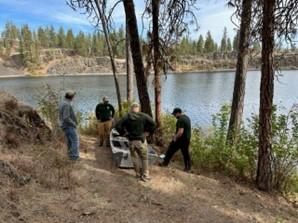
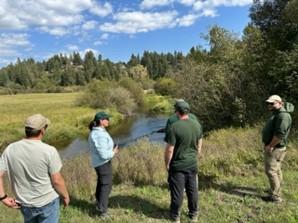
Waikiki Springs Volunteer Project: Inland Northwest Land Council (INLC) hosted a volunteer project at Waikiki Springs Wildlife Area. Access Manager Dziekan and Natural Resource Technician Brant were on-hand that day to represent the agency and help with the clean-up. Dziekan and Brant met with INLC and a group of 12 volunteers, half of which were parents and children in the Girl Scouts, on Saturday, Sep. 16 for a volunteer work project at the Waikiki Springs Wildlife Area. The volunteers picked up litter along the switchback trails. The date of the work project was picked because it was World Cleanup Day, an event aimed at promoting litter cleanup using volunteer service. In total, the group filled six large trash bags to the brim with litter, and a tire. Volunteers spent two hours on Saturday picking up the litter and left with a sparkling clean switchback trail without a piece of litter in sight. There were lots of small children, but no photos of the kids were taken since no releases were signed prior.
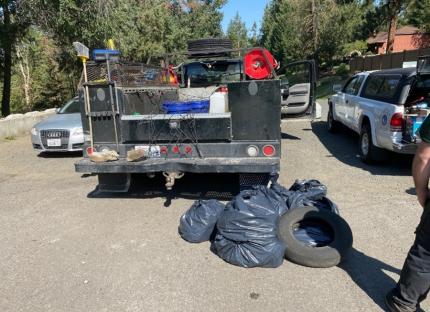
Access Program: Acting Private Lands Biologist Nizer coordinated with a landowner in Albion to enroll in the Hunt by Written Permission Program. Nizer created the landowner's contract and is waiting for approval to have it signed. The property is about 100 acres and is prime habitat for deer, waterfowl, and upland bird. This property will be a highly sought after piece as it is in an area where a lot of hunters drive by.
Contracts: Private Lands Biologist Hadley contacted and met with landowners to extend existing WDFW access contracts expiring soon. Also, he contacted landowners enrolled in WDFW’s Voluntary Public Access Program (VPA) to extend their program an additional year.
Providing Conflict Prevention and Education
Producer Check-In: Wildlife Conflict Specialist Kolb conducted check-ins with producers in the Touchet pack territory and informed them of a recent collaring effort. Wolf Biologist Spence successfully deployed a GPS collar within the Touchet pack. Producers with existing data sharing agreements are now able to view the collar data to aid in range rider deployments and other non-lethal applications.
Depredation Investigation: Wildlife Conflict Specialist Wade and Wildlife Conflict Supervisor McCanna conducted an investigation of two injured calves this week. Both calves were determined to be non-depredations.
Conserving Natural Landscapes
Shrub Order: Private Lands Biologist Hadley coordinated with Private Lands Biologist Baarstad and Plants of the Wild and Wild Lands to complete shrub orders to complete planting plans for this fall and next spring planting projects in Columbia and Walla Walla counties.
Habitat Projects: Private Lands Supervisor Earl met with the local Conservation Districts to discuss potential joint projects. Earl also worked with the Regional Private Lands staff members to put together a large, combined order for trees and shrubs. Earl met with Private Lands Biologist Baarstad to transfer a seeder from Pomeroy to be used on projects in Lincoln County.
Conservation Reserve Program Enhancement: Acting Private Lands Biologist Nizer and Natural Resource Technician Rumiser visited a Conservation Reserve Program site that is enrolled in the feel free to hunt access and conducted weed management by spraying for invasive weeds with the tractor.
W. T. Wooten Wildlife Area Shooting Range: W. T. Wooten Wildlife Area staff members finished rebuilding the fence at the entrance to the Wooten Shooting Range and got the new gates hung. Natural Resource Technician Tritt and Jensen built rests for the gates to sit on while open and placed a large boulder near the corner of one of the gates to keep people from driving into it.
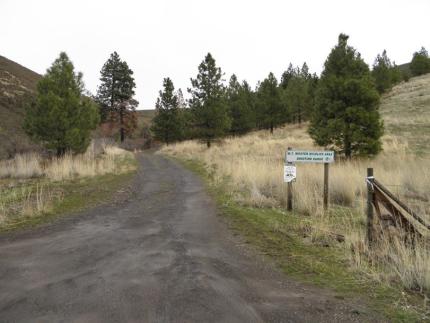
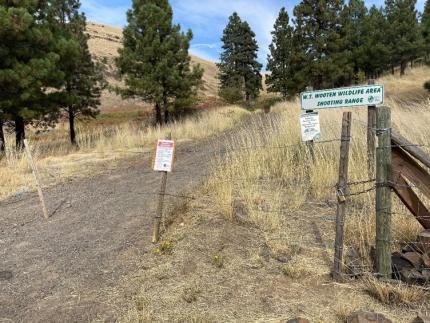
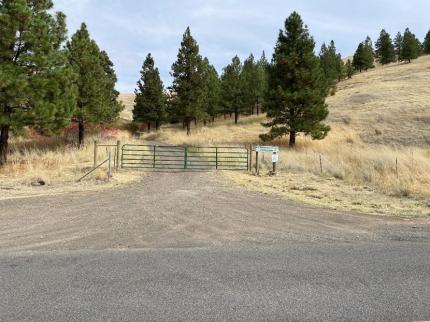
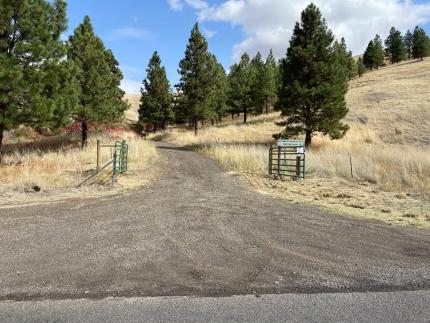
Providing Education and Outreach
Hunter Education: Wildlife Conflict Specialist Kolb assisted with the coordination, teaching, and delivery of more than 24 total hours of instruction for hunter education. Over the course of a one-week period, Walla Walla instructors taught both a traditional class and an on-line class and successfully certified 30 students in hunter education which included an in-depth live-fire field day evolution.
Water Festival: Each year, the Lake Roosevelt Forum sponsors Water Festival, two days of kids’ field trips, where natural resource professionals provide hundreds of area schoolchildren with information about what they do. As they did last year, Sherman Creek Wildlife Area staff members gave a presentation titled “Who’s for Dinner.” Natural Resource Technician Zueger and Wildlife Area Manager Anderson taught about 150 kids from several different schools about upland predators and prey, and the adaptations that ensure their success. The crew had assistance from four high school student assistants (two each day), and on the second day from Chronic Wasting Disease Technician Duncan. The students and Duncan were very helpful and happy to actively participate in presenting information.
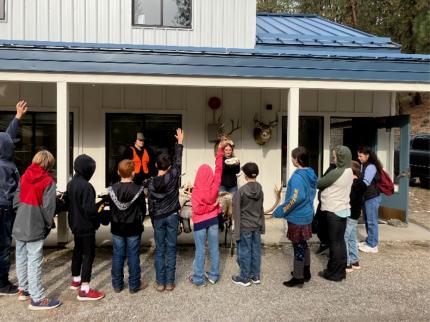
Bear Safety: Biologist Brinkman participated in a bear safety event with local hiking groups at the new library in Spokane Valley. This event reached approximately 60 people and focused on techniques for staying safe in bear country, including a demonstration on the proper use of bear spray using inert canisters.
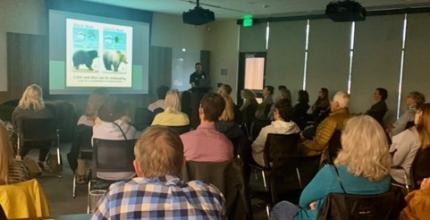
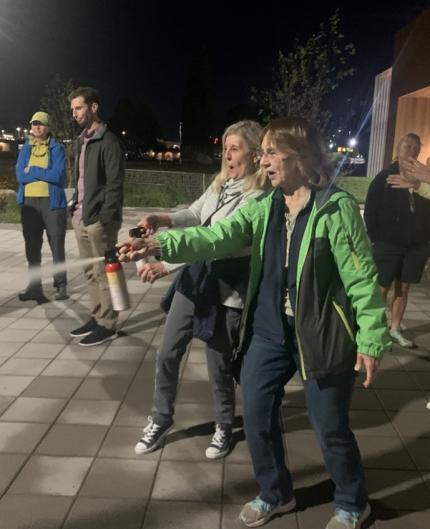
National Hunting and Fishing Day: Biologists Lowe and Brinkman participated in the National Hunting and Fishing Day event at Diamond Lake. The event was intended to introduce youth to hunting, fishing, and the outdoors. It included activities such as catching fish from the dock, shooting firearms and bows, visiting a backcountry camp setup, and talking to falconers that brought live raptors to their booth. Biologists Lowe and Brinkman assisted at the art tent where kids could make their own fish prints using a form of art known as gyotaku, take a plaster cast of animal tracks, build butterfly houses, and draw/color on various coloring sheets. Approximately 600 kids were registered for the event.
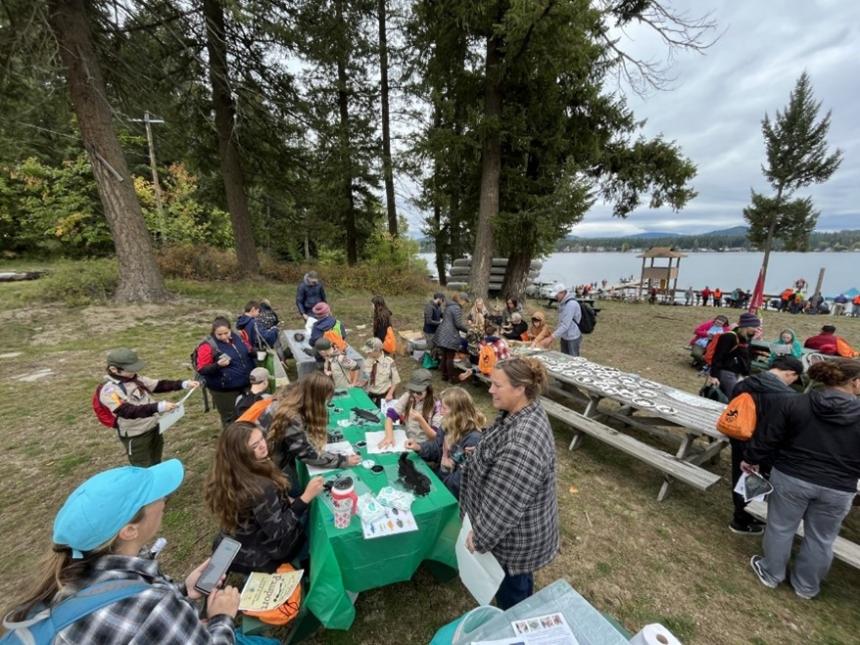
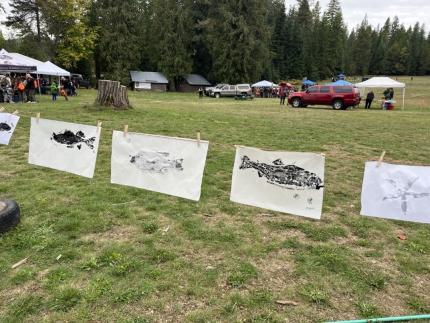
Hunter Education: Wildlife Conflict Specialist Kolb, Hunter Education and Volunteer Coordinator Dazey, and Chief Hunter Education Instructor Hall presented an appreciation plaque to the Walla Walla County Fire District 4. They have provided unwavering classroom support to recent hunter education classes which has made a substantial difference in how classes are delivered to students.
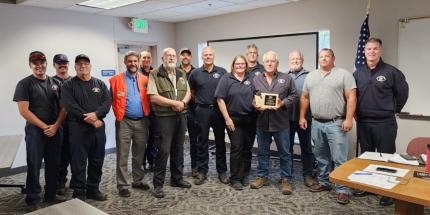
Camp Wooten: Wildlife Conflict Specialist Kolb and Wooten Wildlife Area Manager Dingman taught a full day of classes to 6th grade students at Camp Wooten. The classes covered Blue Mountain wildlife species the students could see during their stay at Camp Wooten.
Managing Wildlife Populations
Oak Creek Wildlife Area Big Horn Sheep Surveys: Oak Creek Wildlife Area Assistant Manager Charlet and Natural Resourse Technician Boggs assisted Ungulate Specialist Moore and various Washington State Department of Fish and Wildlife staff members with a fall Cleman Mountain bighorn sheep population composition survey. This composition count will help estimate lamb to ewe ratios and inform a larger bighorn sheep study currently being conducted across Washington, Oregon, and Idaho. This tri-state study is investigating the “Test and Remove” methodology for the management of Mycoplasma ovipneumoniae (Movi) in bighorn sheep.
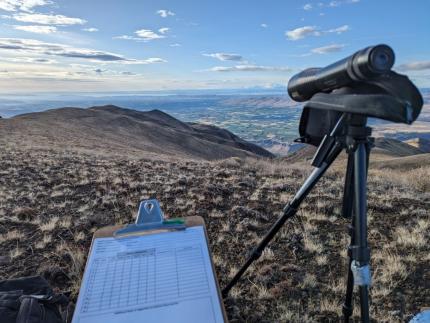
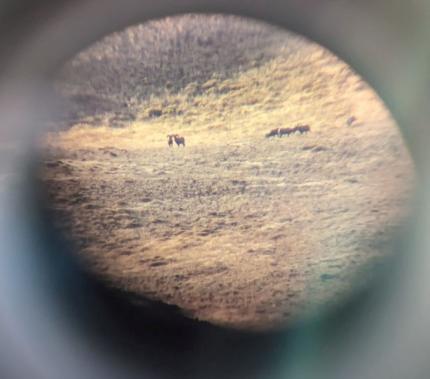
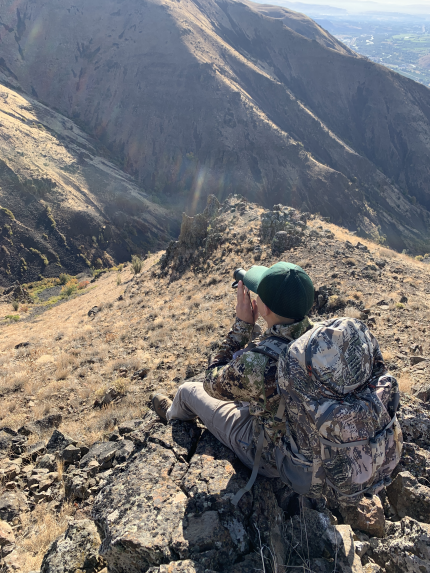
Bighorn Sheep Survey: Private Lands Technician Manderbach assisted with bighorn sheep counts on the Oak Creek Wildlife Area.
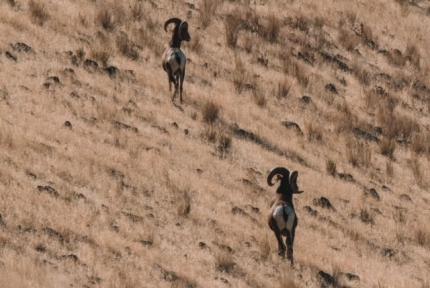
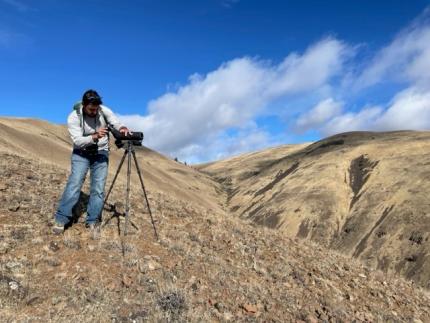
Burrowing Owl Mitigation: District 4 Wildlife Biologist Fidorra worked with City of Pasco consultants identifying potential artificial burrow sites for burrowing owls on city lands and confirming the status of burrows on a site slated for development. Burrowing owls breed in natural burrows on the site, and new artificial burrows should be constructed before the next breeding season.
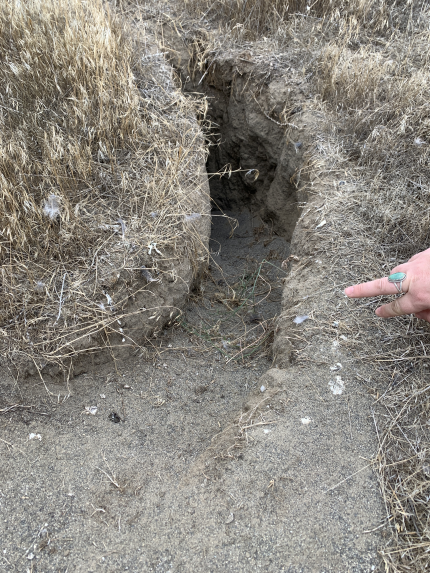
District 4 Waterfowl Banding Complete: District 4 Wildlife Biologist and Natural Resource Technician Manderbach removed waterfowl traps. Fidorra compiled waterfowl banding data and a summary report for the district efforts. The primary goal of Washington State Department of Fish and Wildlife waterfowl banding is to contribute to the Pacific Flyway and state models regarding harvest, movements, and survival. Eighteen trap days occurred, with 802 bands placed across seven species. Age ratios of Hatch-year to After Hatch-year birds was higher than the past two years but still below average, suggesting poor productivity. This pattern was true for mallards at both trap sites, and similar observations were made at the Yakima and Ephrata sites. This year the eastern Washington breeding survey was the lowest in over ten years. Duck trends may lag two years when poor conditions are encountered, meaning the 2021 drought conditions might still be responsible for this year’s low productivity.
Providing Recreation Opportunities
Silver Dollar Landowner Hunting Permit: District 4 Wildlife Conflict Specialist Hand visited ranches enrolled in the Landowner Hunting Permit program to check on hunt opportunities and special permit harvest. Good numbers of elk have been observed recently and most of the special permit holders have tagged out or are scheduled to hunt soon.
Wenas Recreational Trail Planning: Wenas Wildlife Area Manager Hughes has been working closely with recreational planning staff members to discuss trail management strategies throughout the wildlife area. The process for updating the ten-year management plan will be coming up in about a year and part of this will involve recreational management. Before starting the process for recreational planning there must be a solid inventory for all trails and roads. The wildlife area currently keeps an inventory of trails and roads and Lands and Recreation Specialist Frame spends significant time updating data for the wildlife area.
Hughes worked with Recreational Planner Anderson, Recreational Planner English, and Recreation Specialist Browning to line out areas for future inventory needs and discuss the management tactics already in place for recreation on the Wenas Wildlife Area. Additionally, Hughes continued working with GIS staff to make sure they have the most recent trail inventory data for the Wenas Wildlife Area. The Wenas is one of the more popular wildlife areas and receives a high level of recreational use. The wildlife area has been managing recreation for decades and management tactics have developed as needed to address issues and provide the best opportunity for the public while protecting fish and wildlife.
Cottonwood Shooting Area: Wenas Wildlife Area Natural Resources Technicians Janes and Stoltenow installed a wire gate at an access point for the Cottonwood shooting area to help prevent members of the public from accessing the area and potentially leaving trash, while allowing WDFW employees and fire responders access.
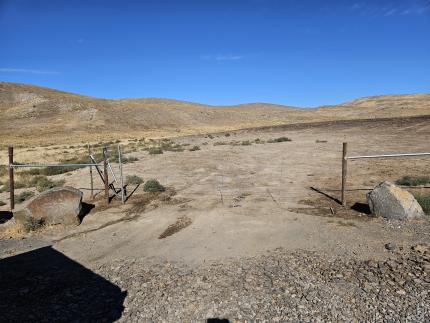
Providing Conflict Prevention and Education
Rattlesnake Hills Elk: District 4 Wildlife Conflict Specialist Hand monitored elk activity and fall wheat planting success. Most fields that were in summer fallow rotation have been seeded and show good germination which will likely draw increasing numbers of elk. Very few of the no-till fields have been seeded as shallow soil moisture has been low, but with recent rain events seeding should commence in the next couple of weeks. Hand assisted one of the disabled special permit holders for the Corral Canyon elk hunt where numerous elk were observed. The hunter harvested a nice bull elk.

Plymouth Deer Damage: District 4 Wildlife Conflict Specialist Hand responded to a deer damage complaint in a wine grape vineyard along the Columbia River in southern Benton County. The vineyard has a history of deer leaving the U. S. Fish and Wildlife Refuge to forage on grape plants and especially the fruit when sugar levels are elevated. Multiple non-lethal hazing techniques are currently being employed as well as archery hunting pressure. A couple of damage permits were issued to assist with deer hazing and removals.
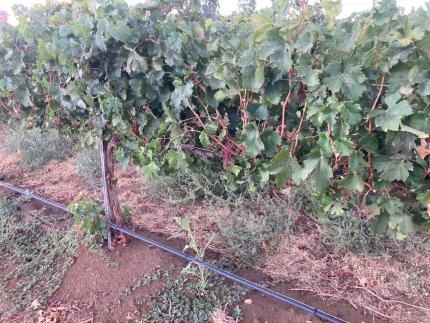
Kahlotus Area Deer: District 4 Wildlife Conflict Specialist Hand patrolled the Kahlotus area to monitor deer activity in newly seeded wheat fields. Many of the seeded fields are showing good green-up and little deer activity was observed. Landowners have already contacted us concerning damage permit issuance to assist with deer damage impacts.
West Richland Deer: District 4 Wildlife Conflict Specialist Hand continued to coordinate with an owner of several small corn fields that have been damaged by deer near the Yakima River. Two additional Master Hunters have been deployed from the Region 3 list.
Lower Buffalo Access: Wenas Wildlife Area Natural Resource Technicians Janes and Stoltenow installed the newly made gate at the entrance to the Lower Buffalo portion of the wildlife area. In addition, they completed the fencing on either side of the gate by stretching and wrapping the wire around the newly installed posts.
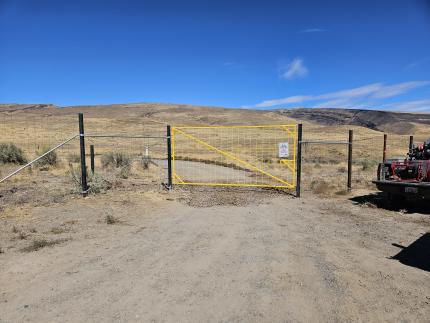
District 8 Kittitas County Conflict: Conflict Specialist Wetzel worked with hay growers and landowners who were having problems with elk in crops and yards.
Wetzel worked with several landowners who were having problems with bears. A bear trap was set near Easton.
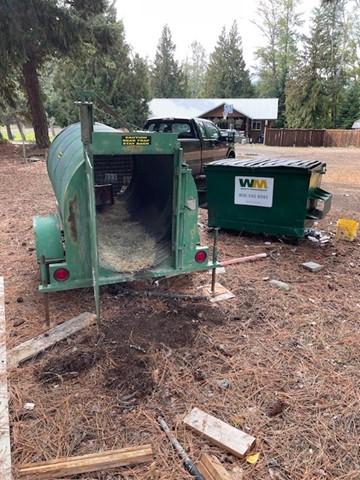
District 8 Yakima County Conflict: Conflict Specialist Wetzel worked with several hay and orchard growers who were having problems with elk and deer in crops. One has requested cost share fencing.
District 8 Deer: Conflict Specialist Wetzel worked on invoices for range riding costs. Several injured deer and deer tangled in netting and fencing were reported. Several deer with arrows were reported, as well as injured fawns or fawns with no doe observed.
Conserving Natural Landscapes
Wenas Wildlife Area Fall Spraying: Wenas Wildlife Area Habitat Specialist Miller assisted Manager Hughes in planning a fall aerial herbicide application on the wildlife area for cheatgrass and knapweed control. This application covered 214 acres of the Wenas Wildlife Area. The herbicides used for this treatment were focused on controlling cheatgrass and knapweed in areas that have developed native grass stands as well. This was a new mix used on the Wenas that has shown success in other parts of eastern Washington and western states. Sites will be monitored in spring and throughout the next few years to review rates of success.
The wildlife area has been working on fall treatment for knapweed. Wenas Wildlife Area Natural Resource Technician Stoltenow continued to spray along roadsides to control knapweed. In addition, Stoltenow worked with Wenas Wildlife Area Habitat Specialist Miller, Natural Resource Specialist Frame, and Natural Resource Technician Janes to spray knapweed in the Roza portion of the wildlife area.
Wenas Acquisition/Conservation Easement Meetings: Wenas Wildlife Area Manager Hughes, Property Acquisition Supervisor Woodruff and Region 3 Lands Agent Carbary met with a few landowners in the Wenas Valley to discuss conservation options on their property and provide updates on potential acquisitions.
They are working on adding .59 acres to The Cleman – Mountain Acquisition that already went through for over 1000 acres. This adjustment is being done in order to properly build a boundary fence and to protect a marsh area.
They also met with the Black Canyon Acquisition landowners, and they provided updates regarding the potential acquisition of 150 acres of shrubsteppe habitat. There is the potential to exchange 40 acres of Washington Department of Fish and Wildlife ground that does not serve valuable habitat nor recreational opportunities. After the meeting it was discussed that the 40-acre exchange would continue to be pursued with this acquisition. The property will be appraised soon as a next step.
The third group of landowners visited were part of the Miracle Mile Acquisition/Conservation Easement. This project is still being decided on. They are trying to determine what method of conservation the landowners are interested in pursuing. This includes approximately 440 acres of valuable habitat for mule deer, upland birds, and songbirds. Shrubsteppe and riparian habitat in Wenas Creek fall within the acres being discussed for conservation.
WDFW hopes to continue working with all of these landowners on conserving their property in the best way that works for both parties.
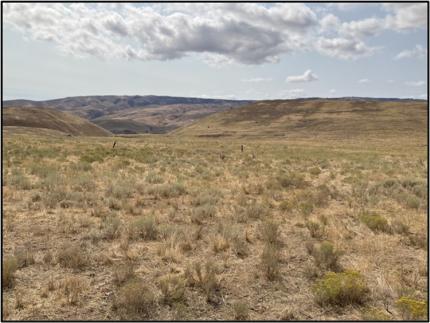
Feeding Site Mowing: Wenas Wildlife Area Natural Resource Technician Stoltenow mowed the feed site to prepare for winter feeding and make it easier to drive through the area while feeding.
Gate Placement: Wenas Wildlife Area Manager Hughes and Habitat Specialist Miller surveyed placement of two gates on a non-green dot road on Clemans Mountain. This will start the Cultural Resource survey process to ensure that sensitive areas are protected.
Barrier Rock on the L. T. Murray Wildlife Area: L. T. Murray Wildlife Area Assistant Manager Winegeart and Manager Morrison moved barrier rock from a gated off camp site on a tributary to S. F. Manastash Creek to the new gate location at Frost Meadows. Winegeart and Natural Resource Technician Blore rearranged barrier rock and added two ecology blocks to the north gate on Shadow Creek. Someone used a grinder to open the north and south gates and created a road around the north gate.
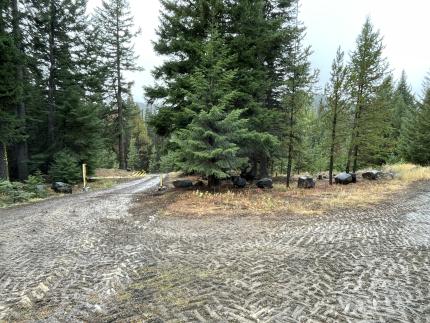
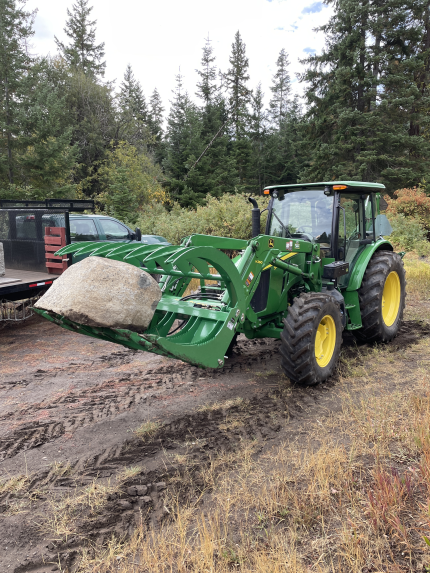
Oak Creek Wildlife Area Post Fire Monitoring: Natural Resource Technician Boggs completed post fire surveys on the Oak Creek Wildlife Area Cougar Canyon prescribed fire units. 235 acres of broadcast burning was completed in the spring of 2021 and fall of 2022. Yearly habitat surveys allow us to monitor current vegetation conditions and compare conditions to pre-fire survey data.
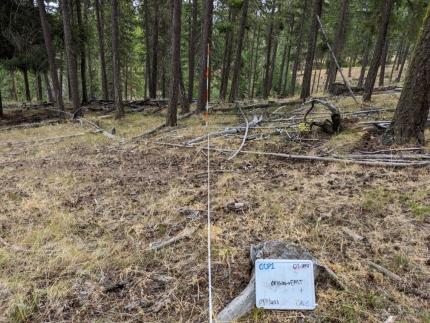
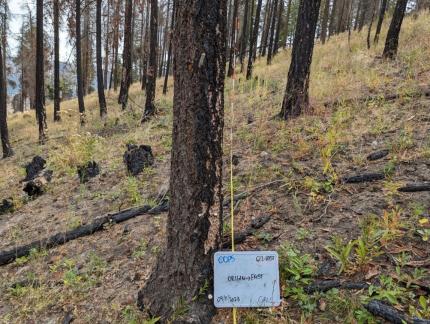
Beaver Dam Analogs on the L. T. Murray Wildlife Area: Manager Morrison met with the Mid-Columbia Fisheries Enhancement Group to look at restoration efforts and took part in a short interview on the Teanaway Valley Unit. Several beaver dam analogs have been installed in the upper meadow and the restoration is nearly complete, with some forest thinning remaining.
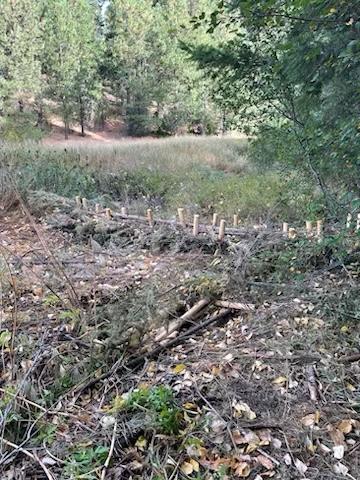
L. T. Murray Fence Markers: Natural Resource Technician Nass installed fence markers on the L. T. Murray’s Whiskey Dick Unit wing fences.
Sunnyside/Snake River Wetland Preparation: Sunnyside/Snake River Wildlife Area Assistant Manager Jahns continued to mow wetlands in preparation for fall reflooding in the Windmill Ranch and Mesa Lake Units.
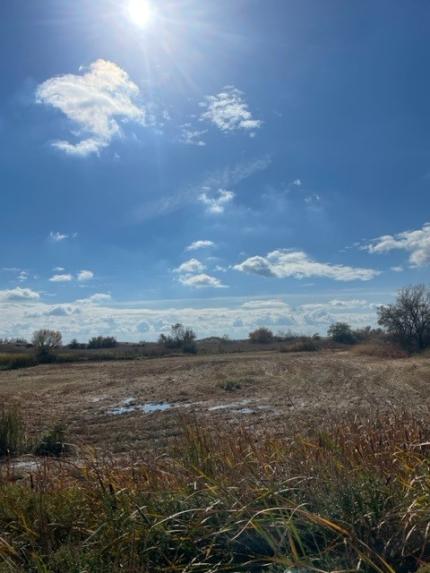
Sunnyside/Snake River Noxious Weed Treatment: Sunnyside/Snake River Wildlife Area Manager Kaelber met with the Yakima County Weed Board to discuss a treatment plan for Clematis orientalis that was discovered growing in the I-82 Ponds Unit. Manager Kaelber followed up the next day with an herbicide treatment.
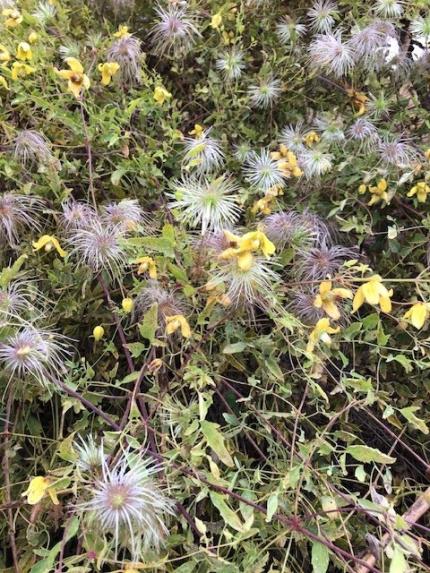
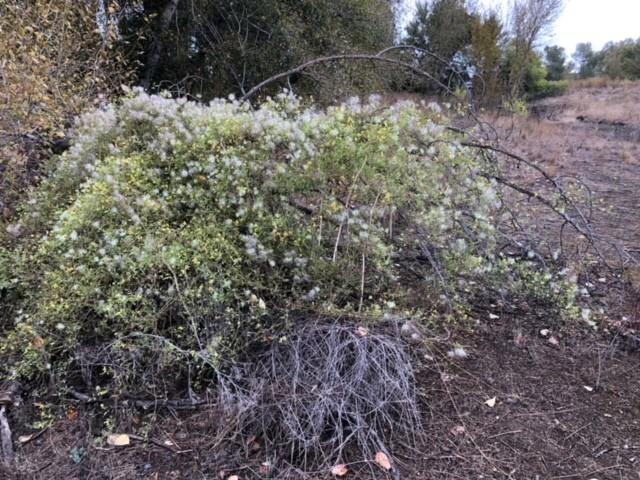
Conducting Business Operations and Policy
Pasco District 4 Office Mailbox: District 4 Wildlife Biologist Fidorra and Habitat Lead Planner Ritter beautifully installed a new locking mailbox at the district office to reduce mail theft.
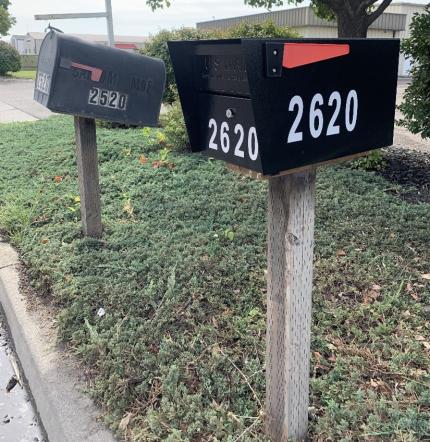
Other
Fabrication and Repair at Headquarters: Wenas Wildlife Area Natural Resource Technicians Stoltenow and Janes replaced parts and did some maintenance on the drill seeder in preparation for fall seeding projects. They also resumed building the wire roller that will be used in the region.
Region 3 Wildlife Area Staff Quarterly Meeting: Sunnyside/Snake River Wildlife Area staff members attended the quarterly regional wildlife area meeting hosted by the Colockum Wildlife Area staff members. The meeting included a boat tour of culturally significant sites within the Colockum, as well as informative meetings with WDFW habitat and cultural resources staff.
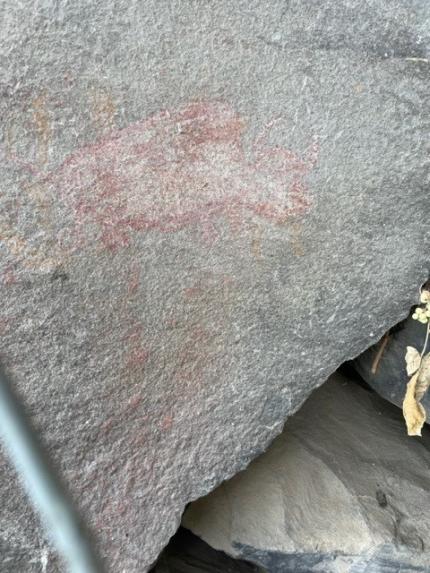
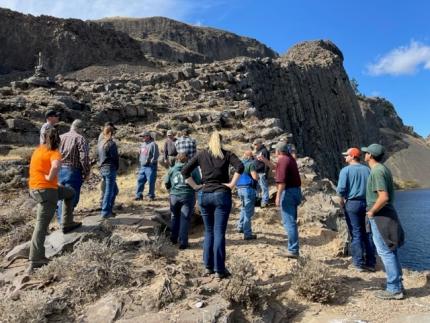
Managing Wildlife Populations
Probiotic Bat Capture in Darrington: Biologist Licence participated in a second round of captures at a Yuma myotis and big brown bat roost in Darrington. These captures are associate with a white-nose syndrome research project aimed at determining the efficacy of a probiotic treatment (among other things) to this devastating disease.
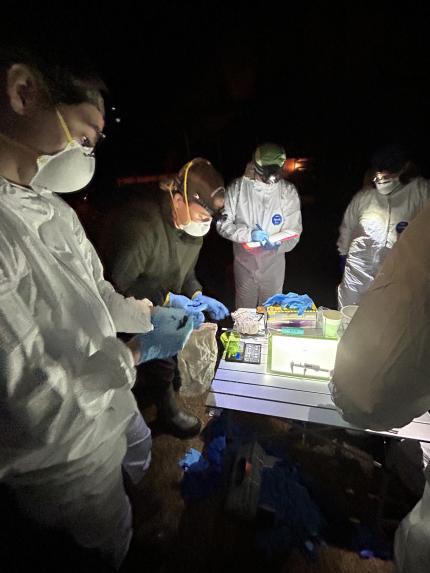
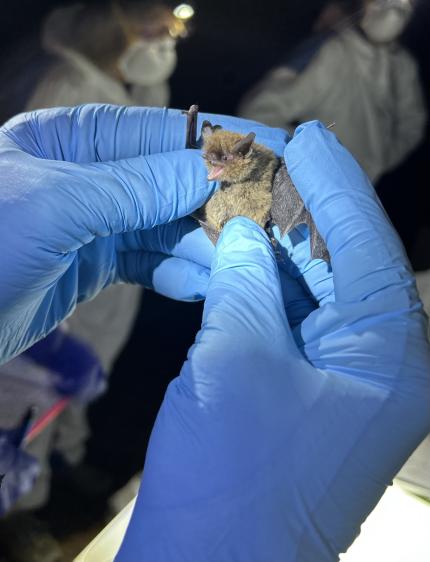
Red Fox Trapping on San Juan Island: Biologist Licence co-lead a capture effort with Wildlife Veterinarian Dr. Haman targeting red foxes on San Juan Island. This project was initiated to conduct a baseline health assessment of the San Juan foxes for comparison to the endangered Cascade red fox population. Additionally, this provided an opportunity to optimize an immobilization drug dosing protocol and provided experience for a University of Washington PhD student currently planning a research project to conduct similar work on Cascade red fox. Outwitting a fox proved to be as challenging as one may guess! However, the team did not leave empty handed, and gained some valuable information and relationships. Many thanks to the participants that made this effort possible.
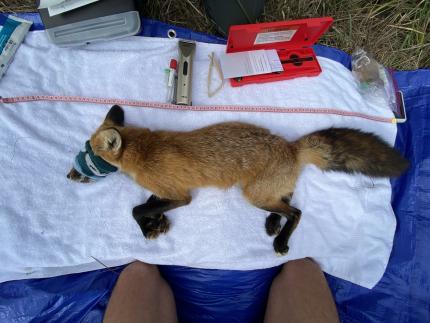
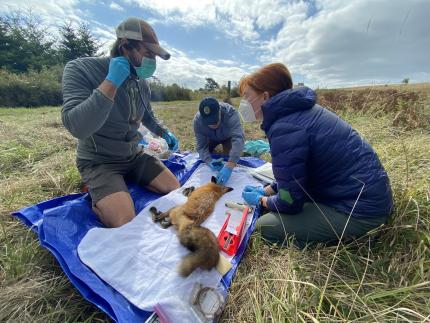
Bat Recon on Whidbey Island: Biologist Licence met with a north Whidbey Island landowner and Washington State Parks biologist to survey a bat roost in their attic and provide recommendations for supporting the local bats in this urban landscape. The visit generated great ideas and goodwill that appears to be formulating into a volunteer project with numerous roosting sites and bat boxes installed throughout the area.
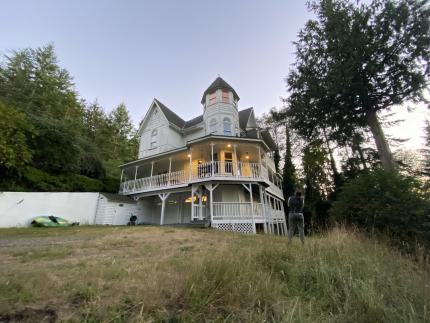
Non-native Species Management: Biologist Licence collected multiple individuals of non-native species for documentation, sampling, and removal from the environment. A unique example is the detection of an eastern United States species, Bombus impatiens (common eastern bumble bee), at a nursery and greenhouse near La Conner. This is the first it has been detected between Bellingham and Seattle, and it has started to invade into Washington from Canada because of Canadian efforts to import this species to support crop production. Similarly, a snapping turtle was found in Oak Harbor on Whidbey Island, it was removed with the help of a local veterinarian and swabbed for Emydomyces testavorans, a turtle shell disease fungus.
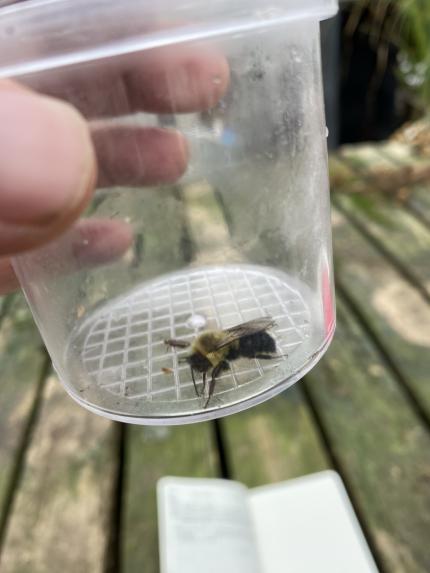
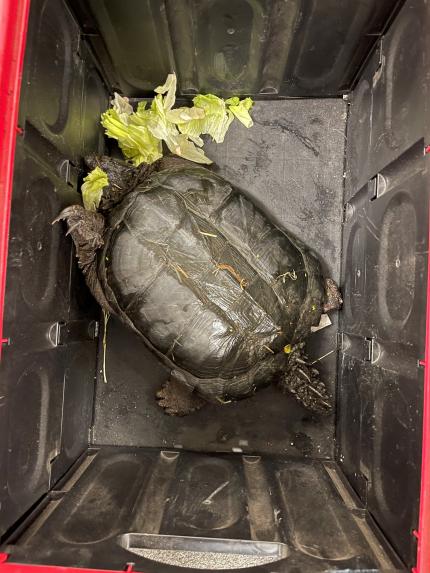
Providing Education and Outreach
Ebey Island Pheasant Release: Wildlife Area Manager Boehm meets and greets early morning hunters during the pheasant season opener at Ebey Island. A fog-free morning set the stage for a great day of hunting. Manager Boehm answered questions, explained safety factors, and greeted new and returning hunters to the start of another season. The parking area was full and busy throughout the day.
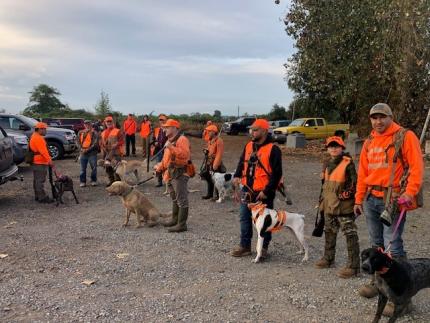
Managing Wildlife Populations
Fish Removal: Biologists Wickhem and Bergh spent two days removing non-native fish from a lake inhabited by state-endangered northwestern pond turtles. The fish compete with the turtles for food and the larger fish eat hatchling turtles. The water in the lake was extremely low which caused the fish to be concentrated in small pools. The mud made it difficult to get around, but many five-gallon buckets of fish were removed.
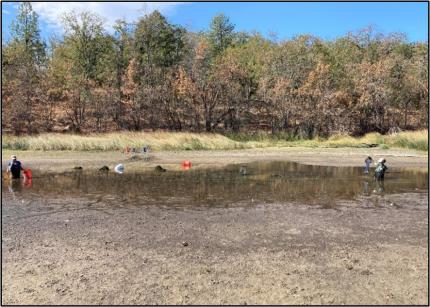
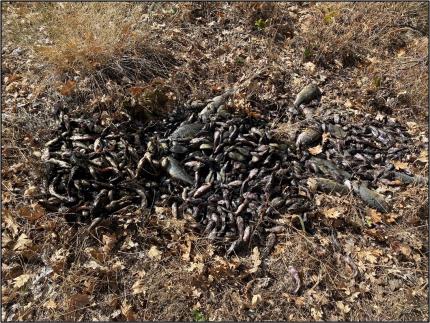
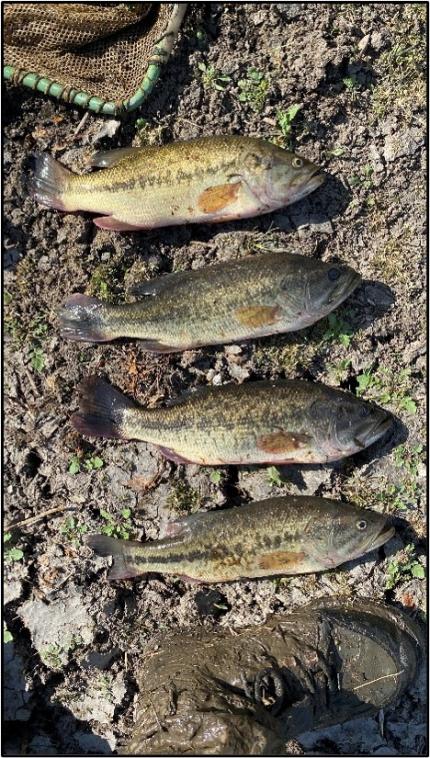
Columbian White-tailed Deer Population Monitoring: Biologists Holman and Stephens along with Wildlife Area Assistant Manager Risley joined U. S. Fish and Wildlife Service Biologist Kruenegel to set cameras in habitat occupied by Columbian white-tailed deer in Cowlitz County. The camera sets are designed to generate data to determine the current relative abundance of Columbian white-tailed deer verses black-tailed deer in specific areas where the species are sympatric (occupying the same habitat and location). The photographs will be collected in the coming months and used to complement aerial surveys for the white-tails that will happen next February.
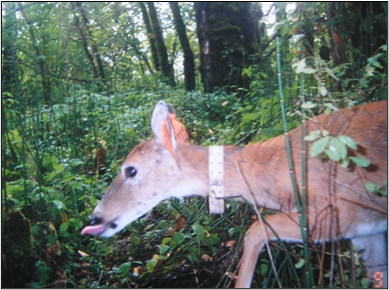
Columbian White-tailed Deer Necropsy: Biologists Holman and Stephens joined U. S. Fish and Wildlife Service Biologist Kruenegel and Assistant Refuge Manager Bonello to necropsy a Columbian white-tailed deer that was euthanized in Wahkiakum County. The deer was acting abnormally and very emaciated. The necropsy revealed worn teeth and further demonstrated the deer’s poor nutritional state (zero fat over the heart or kidney). No specific signs of disease were noted, and lung, liver and heart tissue all appeared normal. Evaluation of stomach contents failed to reveal atypical foods. Samples for Chronic Wasting Disease, ageing, and genetic testing were collected and retained by U. S. Fish and Wildlife Service.
Columbia Gorge Pika Surveys: Biologist Wickhem completed four surveys for American pikas in the Columbia River Gorge this September. Wickhem was assisting with a long-term monitoring project run by the U.S. Geological Survey that tracks pika occupancy at many sites throughout the Gorge. This season, the project was focused on “edge sites” or areas that are considered either at the edges of the pikas' range in the area, or the edges of what is considered the Gorge habitat verses more traditional mountainous/alpine pika habitat. Throughout North America, American pikas are usually only found in higher elevations, but the Columbia River Gorge is the only place where American pikas occur at near sea level. Collared pikas, that live in northern Canada and Alaska, can live at sea level but are a different species. On these surveys, Wickhem confirmed pikas at three out of the four sites either by hearing calls or by finding fresh hay piles (pika food cache) and latrines.

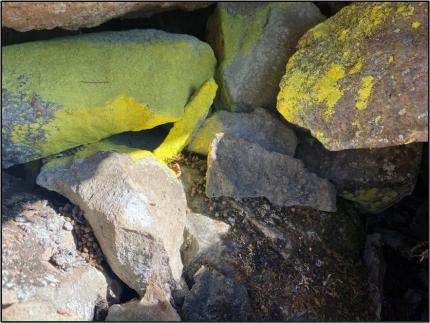
Klickitat Mule Deer Mortality Investigation: Biologist Wickhem investigated the mortality signal from a collared female mule deer this week. From the map of its recent locations, it appeared the doe had been hit by a car, but when Wickhem arrived it was obvious that she had been aggressively scavenged by coyotes for several days. It was impossible to tell if the coyotes had killed her next to the road, or if she had been hit by a car and found by the coyotes soon after. This deer is part of a four-year study being conducted throughout GMUs 388 and 382 to track the annual movements of female mule deer and locate important migration corridors. Staff members are also attempting to determine cause of death when an animal dies, which has proven to be difficult. In winter 2021, 81 collars were deployed throughout GMUs for this effort. Twenty-two collars were deployed in the winter of 2022 and 23 were deployed in winter 2023. Most of the redeployments replaced study deer that died over the first two years of the study. We are nearing the end of the study so this collar will not be redeployed for this project.
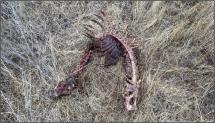
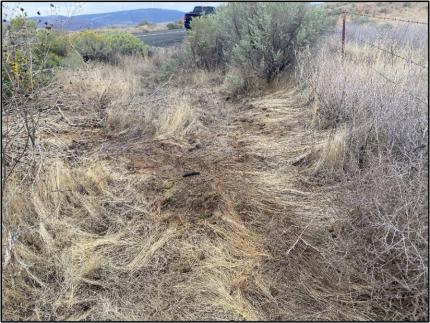
Providing Conflict Prevention and Education
District 9 Calf Depredation: Wildlife Conflict Specialist Jacobsen followed up on a report from the Klickitat County Sheriff’s Office of a cougar depredation on a domestic calf. The landowner had observed the cougar feeding on the calf carcass and called the Sheriff’s Office, who came out and located and killed the cougar with the use of hounds. Jacobsen arrived and confirmed the depredation as a cougar depredation. He will work with the livestock producer on filing a livestock loss damage claim if he is interested.
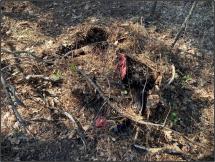
Injured Deer: Wildlife Conflict Specialist Jacobsen was contacted by a homeowner who was concerned about a deer in his yard. The deer had an injury to its side and the homeowner believed the deer needed to be euthanized. After examining photos of the deer, Jacobsen advised the homeowner that the deer would likely survive and that it should be left alone. Jacobsen also reviewed with the homeowner multiple reasons why supplemental feeding of deer is actually harmful to the deer. The homeowner agreed to stop feeding the deer.
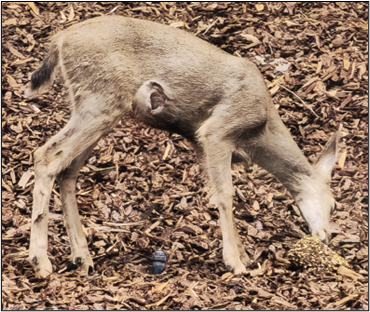
Second Injured Deer: Region 5 Wildlife Program staff members were contacted by a homeowner regarding a deer with netting tangled around its antlers. Both District Biologist Bergh and Wildlife Conflict Specialist Jacobsen attempted to contact the reporting party multiple times. It is unknown what became of the entangled deer.
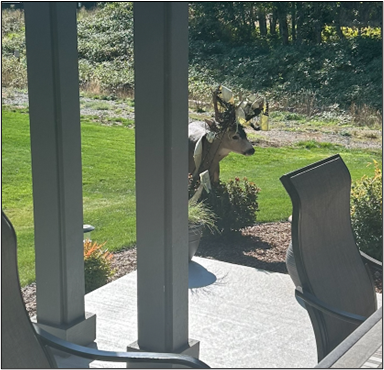
Another Injured Deer: Wildlife Conflict Specialist Jacobsen spoke with a landowner who reported a sick or injured deer laying in her yard. Jacobsen reviewed the photos and agreed that the deer was in poor condition and likely needed to be euthanized. Sargent John authorized the landowner to euthanize the deer.
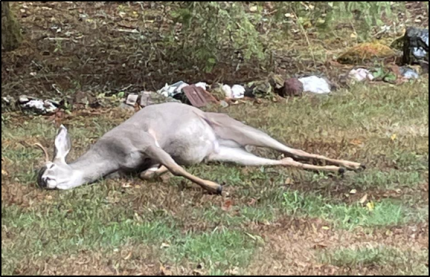
Fourth Injured Deer: Washington Department of Fish and Wildlife Dispatch contacted Wildlife Conflict Specialist Jacobsen regarding a deer that had been caught in a fence in Goldendale and that needed to be euthanized. Jacobsen adjusted his plans and met Goldendale Police Department staff members on scene. The deer was no longer caught in the fence but had incurred severe injuries from the incident and needed to be euthanized. Due to the deer’s location in a residential area, Goldendale Police Department staff members determined that it was not safe to discharge a firearm in the area and requested Washington State Department of Fish and Wildlife assistance. Jacobsen successfully immobilized the deer with a dart gun and was able to transport the immobilized deer to a safer location to euthanize it. It is not uncommon for deer (especially fawns) to get caught in fences, particularly around residential neighborhoods. Homeowners should seek to install wildlife-friendly fencing (PDF)around yards to prevent deer from getting caught on fences as they try to cross.
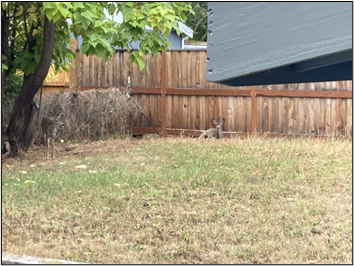
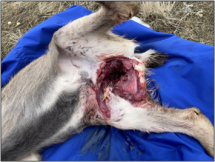
Camas Bear Sightings: Wildlife Conflict Specialist Jacobsen fielded multiple calls regarding a bear wandering around the Lacamas Lake, Camas area. It appears the bear made a few wrong turns and spent several days trying to figure out how to leave the urban area.
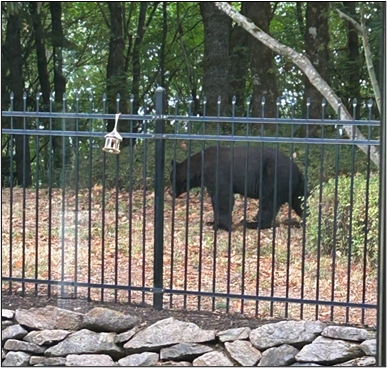
Elk/Deer Fencing Project Inspections: Wildlife Conflict Specialist Jacobsen completed several fence project inspections for elk/deer proof fencing. Over the past four years, the Washington Legislature has appropriated funding for Washington Department of Fish and Wildlife to enter into cost-share fencing projects with commercial agricultural producers who are experiencing substantial elk and deer damage to crops. So far, Jacobsen has completed 11 cost-share fencing projects totaling almost 5.5 miles of fencing around commercial operations, ranging from vineyards to produce to oat crops. Jacobsen spent time this week mapping out and obtaining quotes for additional fencing projects in District 9.
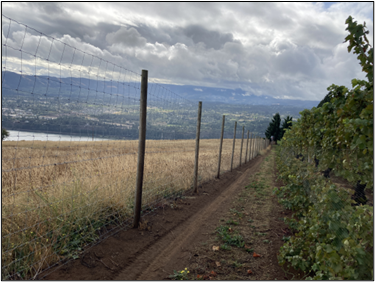
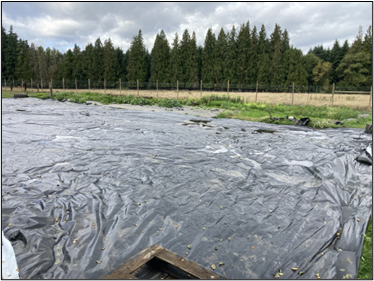
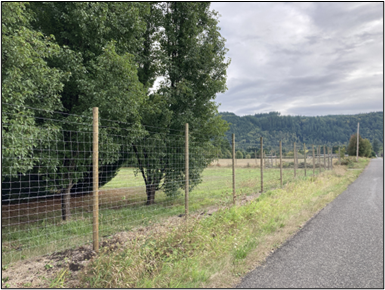
Sheep Depredation: A landowner contacted the Department of Fish and Wildlife regarding two sheep that went missing and one that he found dead in his pasture. Unfortunately, the landowner burned the sheep carcass the day prior, so it was not available for inspection. Wildlife Conflict Specialist Jacobsen, accompanied by Regional Operations Manager Varley, responded to the sheep farm. After walking the perimeter of the pasture and not finding any signs of the sheep, Jacobsen began exploring the woods and creek bottom across the street. Jacobsen located one of the missing sheep carcasses in the creek bottom. Jacobsen provided advice and hazing materials to the landowner, and strongly encouraged him to begin penning his livestock up at night.
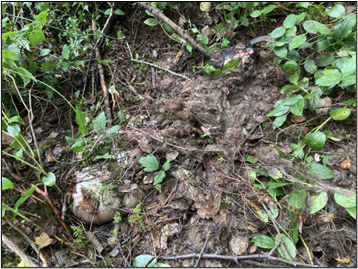
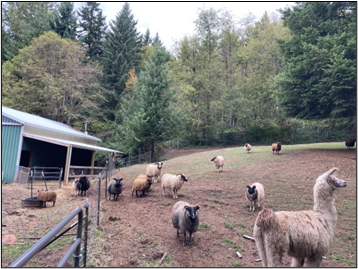
Coordinated Resource Management Planning Meeting: Wildlife Conflict Specialist Jacobsen attended a Coordinated Resource Management Planning meeting with Klickitat County livestock producers and land managers to discuss wolf-livestock range issues.
Conserving Natural Landscapes
Eagle Island Unit: Approximately five weeks were spent this August and September treating Scotch broom and knotweed on the Eagle Island Unit of the Mt. St. Helens Wildlife Area, located in the North Fork of the Lewis River. This island is normally only accessible by boat, but during the month of August, river flows are low enough that staff members can access the island by foot or UTV.
Treating knotweed is generally not very fun. These days are long, the weather is muggy, the bugs are plentiful, and the three gallon backpack sprayers feel excessively heavy at the end of the day. However, at the end of an intense knotweed season, staff members get the satisfaction of watching the knotweed turn crispy and brown. It is even more satisfying kayaking down the river, surveying the shoreline for any knotweed plants that have escaped herbicide treatment. Assistant Manager Risley and Technician Crane made this float in approximately three hours, treating knotweed and purple loosestrife along the way.

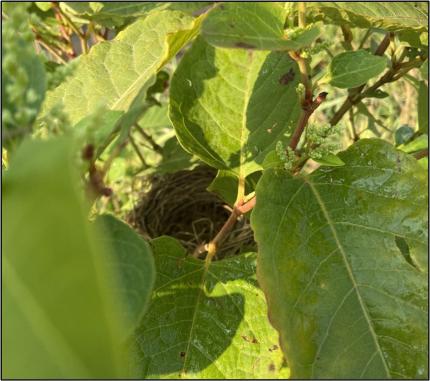
Merrill Lake Unit: Just in time for hunting season, Technician Crane and Assistant Manager Risley visited each of the official campsites at the Merrill Lake Unit to replace signs that went missing this summer. Unauthorized campsites were disassembled, and trash was cleaned from every site. Well-worn trails to the falls indicate that recreational use of the unit has been very high this year.
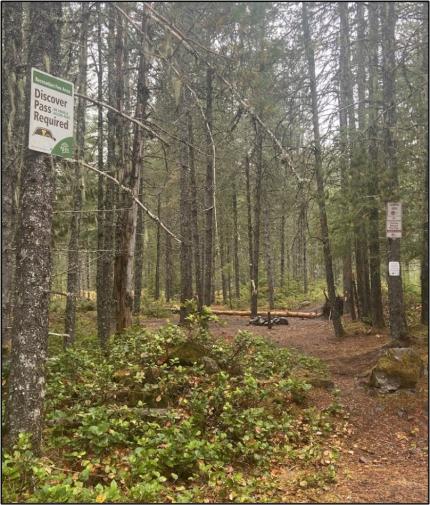
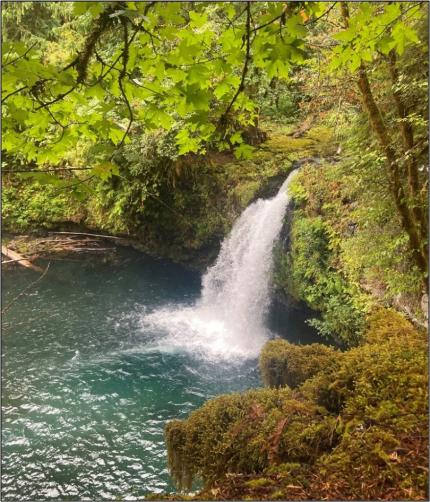
Simcoe Boundary Marking: Biologists Wickhem and Bergh spent two days refreshing the signs marking deer area 5382 Simcoe as well as marking the new property lines at the Simcoe Unit of the Klickitat Wildlife Area. Washington Department of Fish and Wildlife recently acquired two new parcels, one on the south edge of the unit and one on the west edge of the unit. The new parcels are included on the map on WDFW’s Simcoe Unit webpage as well as on the Klickitat County Assessor’s online mapping tool.
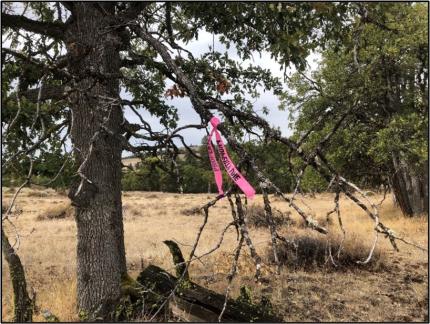
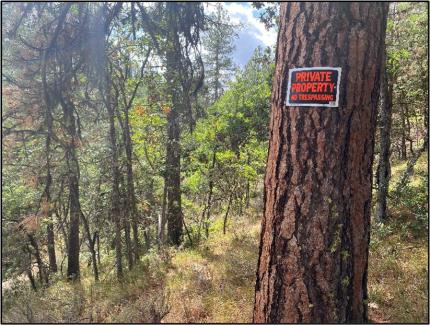
Providing Education and Outreach
Mt. St. Helens Wildlife Area: Professors and students from the University of Nottingham’s Mt. St. Helens Field Course visited the Mudflow Unit to collect geographical data at multiple cross-sections of the North Toutle River flood plain. This is the 16th year of data collection that the university has collected in their ongoing study of Mt. St. Helens and the sediment and debris flow since the 1980 eruption. Assistant Regional Wildlife Program Manager Hauswald and Assistant Manager Risley met up with the students and their professors during their lunch break to talk with them about the elk management and conservation work that is done by Department of Fish and Wildlife at the wildlife area.

Vancouver Wildlife League Presentation: Biologist Holman presented on southwest Washington elk management to a group of approximately 20 members of the Vancouver Wildlife League. The presentation featured the history of local elk spanning 1980-2023, Washington State Department of Fish and Wildlife (WDFW) work to better understand the effects of Hoof Disease, WDFW management efforts surrounding Hoof Disease, and population information. Thanks to the Vancouver Wildlife League for their involvement in hunting and fishing related activities and advocacy spanning nearly 100 years in southwest Washington. For more information on the group see their website here: About us (vancouverwildlife.org) Thanks as well to Regional Director Sallee for attending the presentation.
Providing Recreation Opportunities
Dungeness Hunting Point: Wildlife Area Manager Laushman and Biologist Ament prepared the River’s End site of the Dungeness Unit for waterfowl hunting season and refreshed safety signage at the Helen’s Pond site.
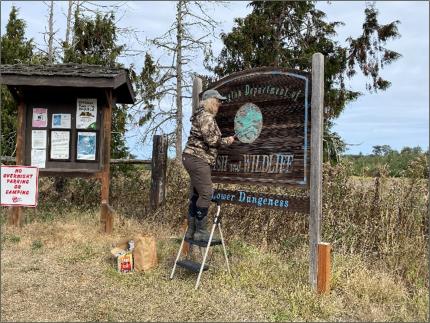
Providing Conflict Prevention and Education
Osprey On Cell Towers: Biologist Tirhi worked on three permit requests for osprey nest removals on cell towers in Olympia, Lake Tapps, and Vaughn. Companies can legally remove nests from cell towers outside the active nesting season, on inactive sites, or sites finished for the season using a permit issued by Washington State Department of Fish and Wildlife.
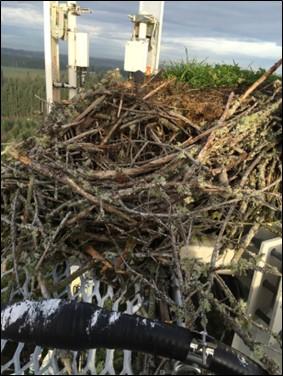
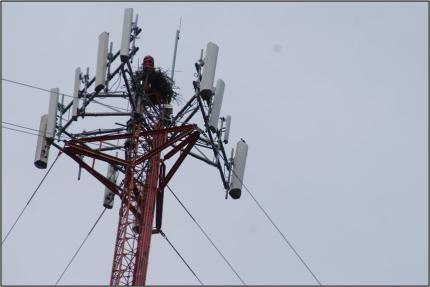
Conserving Natural Landscapes
South Puget Sound Prairies: Biologists Tirhi participated in an all-day workshop hosted by Washington State University extension (Thurston County) and held at Thurston Conservation District to discuss conservation easements for remnant prairies of South Puget Sound. Conservation easements are a tool widely used in habitat conservation whereby private lands are retained by the landowner, but certain uses of that land are bought so that those uses cannot be implemented on the site. Uses usually include removing the ability to convert the habitat to other uses like pavement, buildings, and infrastructure but might also dictate activities like grazing, farming, and water use.
The workshop was geared at introducing Northwest Rangeland Trust, a rancher-lead non-profit land trust based in northeast Oregon. This land conservancy currently owns two conservation easements in Thurston County and may be available to purchase more, particularly on working lands having remnant prairie. Significant funds will soon become available for remnant prairie land acquisition (including conservation easements) and listed prairie species enhancement through the Thurston County Habitat Conservation Plan and Department of Defense, Joint Base Lewis-McCord (JBLM) Readiness and Environmental Integration (REPI) program.
Read more about the Habitat Conservation Plan here and the JBLM REPI program here. Other local land trusts are also poised to participate in expanding their capacity and acquisitions through this funding. Trusts such as Capitol Land Trust, Community Farm Land Trust, and South of the Sound Community Farm Land Trust have a long history of successful land conservation in the South Puget Sound and do exceptional work. One thing is certain, it will take all partners working together to conserve remnant prairie and recover listed prairies species in the South Sound region.
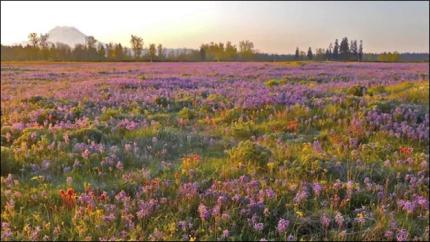
Providing Education and Outreach
Theler Wetlands Restoration Public Meeting: Washington Department of Fish and Wildlife and Hood Canal Salmon Enhancement Group held a public meeting at the Salmon Center in Belfair to present future restoration work at the Theler Wetlands. Plans for removal of a breached levee, restoration of the natural estuary, and a future boardwalk to connect the walking trails were presented, followed by a question and answer session. The next public meeting will be on Wednesday, Oct. 18 from 4:30 p.m. to 5:30 p.m. at the North Mason Timberland Library in Belfair.
South Puget Sound Wildlife Area Work Party: A volunteer opportunity is coming up for interested participants at the South Puget Sound Unit in Lakewood, on Oct. 7 from 9 a.m. to 1 p.m. Activities will include planting native plants, pulling Scotch broom, preparing a restoration area for plantings and signage, and pruning trees. Contact Katie Laushman with any questions.
Conducting Business Operations and Policy
Nisqually Indian Tribe Co-management: Biologist Tirhi arranged a collaboration meeting with Washington State Department of Fish and Wildlife (WDFW) Regions 5 and 6 Wildlife Program staff members, Nisqually Indian Tribe Wildlife Program Manager Borrego, U.S. Fish and Wildlife Service partners, and WDFW Wolf Specialist Lead Maletzke to discuss and plan wildlife co-management opportunities between Nisqually Indian Tribe and WDFW. Wolf monitoring was the main emphasis.
Camp Murray Integrated Natural Resources Management Planning: Biologist Tirhi represented WDFW at the Camp Murray Integrated Natural Resources Management Planning (INRMP) workshop held at Camp Murray, Pierce County. Camp Murray is located adjacent to and is home to the Washington Army National Guard, Washington State Guard, and the Washington Air National Guard. It has been a military post since 1855. Camp Murray encompasses approximately 295 acres containing American Lake shoreline, oak woodlots, conifer forest, remnant prairie soils, Murray Creek, buildings, and infrastructure.
The Sikes Act requires most military installations within the United States to develop and implement a comprehensive plan for natural resource conservation and management (for example, fish and wildlife, forestry, land management, outdoor recreation) on the installation. The INRMP requires both federal and state representation and signatures. Tirhi reviewed the current draft INRMP and participated in the full day planning meeting. WDFW appreciates the dedication shown by the Washington Army National Guard, Washington State Guard, and the Washington Air National Guard in preserving legacy wildlife and habitats on the installation and planning for their conservation and enhancement.
Region 6 Senior Staff Visit: The Wildlife Program senior staff group visited the Nisqually Unit of the South Puget Sound Wildlife Area, which is shared with the Luhr’s Landing Water Access Area and the Nisqually Reach Nature Center. Staff members from the Nature Center gave a tour of their facilities to the group. The Nature Center is open to the public on the weekends and provides summer camp opportunities in the summer.
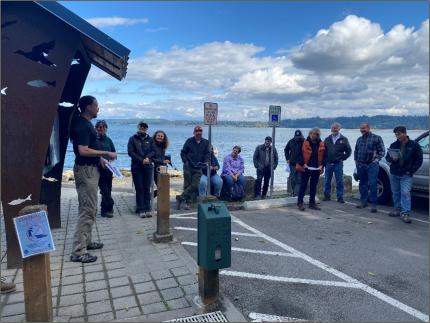
Billy Frank Jr. Nisqually National Wildlife Refuge Visit: Staff members from Regions 4 and 6 toured the boardwalk at the Nisqually National Wildlife Refuge to learn about engineering successes and challenges involved in tidal boardwalk trails, to inform potential boardwalk designs at WDFW wildlife areas.
